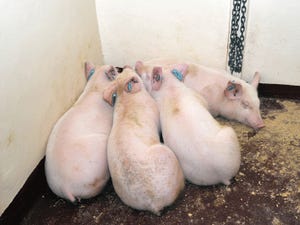Company explores new ‘reality’ tool
AP’s World Pork Expo display used augmented reality to showcase the company’s new positive-pressure ventilation system for hog buildings.
June 25, 2018

By Willie Vogt
Tucked in a corner of the Varied Industries Building at World Pork Expo this year was a frame essentially representing a hog building, but there was little to see, unless you were wearing the right glasses.
AP, a brand of Agco, was sharing information about its new positive-pressure ventilation system for hog buildings in a unique way.
“We’re showing this facility with augmented reality,” said Lance Brown, global learning and development director for Agco’s grain and protein brands, which include AP, GSI, Cumberland and Cimbria. “It’s a way to show visitors the building in greater detail.”
Augmented reality is different from virtual reality in that users are “overlaying” an image on their vision rather than immersing themselves into an image.
At the building display, the visitor could see parts of the positive-pressure system from filters to the evaporative cooling system to fans and finally to exhausters at the end of the building. “It gives the visitor a chance to see how the system will work,” Brown said.
One potential benefit of the mixed-reality approach to showing a design is to give the viewer a chance to see how the finished product would look before anything is done on the farm.
“We had a farmer ask a design question going through this,” Brown said. “He wondered if the evaporative cooler could go before the filter. Visualizing how something will work on your farm makes a difference.”
Beyond building demos
For AP, augmented reality offers potential for the future. Brown, who got into the tech as a way for the company to enhance its training, sees a future for mixed reality that could change how farmers and their employees work.
“In the future, a farmer could get an alert about a failure in a building. That failure could be ‘Fan 20’ in the building,” Brown said. “An employee entering the building might not know which is Fan 20. But with augmented reality, he or she could put on the glasses, and that specific fan would ‘stick out.’ It might blink red in the display.”
Finding the fan is a plus, but Brown sees a day when they would approach the fan and the mixed-reality system would go to the next step by telling what is wrong with the fan and provide specific repair instructions to fix it.
“Think of how much more efficient an employee could be with that tech,” he said.
Brown acknowledges that this is “future tech,” but he noted it’s something he can see coming.
GSI and AP are working with the University of Illinois on these new tools.
Interns for the company have developed the current systems — one for AP showing the positive-pressure system, and for GSI, showing customers how grain systems might look from scratch, or with additions.
Moving target
Right now, GSI and AP are demonstrating their mixed-reality systems on Microsoft Hololens units, which allow a user to “see” the digital image as an overlay on their real environment on the glasses. But Brown sees this tech just getting started.
“With this, it’s like we’re where the internet was 20 years ago,” Brown said. “The glasses used today are big, but that will change.”
He pointed to prototype glasses from Intel that look more like everyday reading glasses (perhaps with bigger frames).
Back to that “hog facility” at World Pork Expo. The building frame “contains” the building example, and visitors were walking in, seeing the filtration setup, looking at the evaporative cooling system and checking out the fan. It was a simple demonstration, but it’s just a start.
AP could also implement this tool for facility design in the future.
You May Also Like



